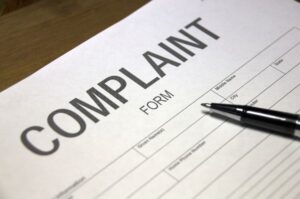Whinge, whinge, whinge – do you HAVE to deal with customer complaints??
 Have you ever sent a steak back in a restaurant because instead of being rare, it was extremely well done?
Have you ever sent a steak back in a restaurant because instead of being rare, it was extremely well done?
Or returned a clothing item to a store because the large size was big enough to accommodate you and a friend?
Your memory of how a company handles your complaint will colour your impression of the company. If you were happy with your treatment and their response, you’ll be more likely to return and tell others.
And if not…well, social media makes it VERY easy for disgruntled customers to share their thoughts with others.
Let me tell you a story
Our Principal Advisor Maree Stuart recently shared this story:
Back in the day when I worked for NATA, I would often receive phone calls from disgruntled clients complaining about their assessment, the way someone in NATA had treated them, or that another NATA lab was doing something wrong. (Shocking, I know, to think that this would ever happen!)
One day, I received a call from the owner of a NATA lab who was upset about something to do with NATA (the substance isn’t important). It was clear when I took the call that this person was upset.
So, I listened, took down the details of the concern, and empathised. At the end of the conversation, I asked what the person would like for us to do about his concern. After giving this some consideration, the owner calmly said he didn’t think there was anything that could actually be done. The owner thanked me for patiently listening to the concern and we said our good-byes.
I passed on the details of the interaction with the person in NATA in charge of dealing with complaints and he duly noted this in the records, including its resolution.
Later that day, I was surprised when the owner arrived at the NATA offices with a cake in hand (there was an excellent cake shop a few doors up from the lab).
All the owner wanted was someone to listen to the concern.
The lesson is that, handled properly, a complaint can get you cake (or at least a very positive outcome that results in a stronger relationship of trust)!
So, what do you need to do to get this kind of outcome?
What does the Standard say?
 If your lab holds ISO/IEC 17025 or ISO 15189 accreditation, you will need to have a documented process for complaints.
If your lab holds ISO/IEC 17025 or ISO 15189 accreditation, you will need to have a documented process for complaints.
This means that you’ll have something that outlines the steps for receiving, evaluating, and making decisions on any complaints that come into the lab.
This could be a written procedure, flow chart, excel spreadsheet etc. Whatever method you adopt for documenting the process, you need to include at least the following:
- A description of how a complaint may be received
- The process for validating and investigating a complaint
- How decisions on actions to be taken will be made
- How the lab tracks and records the complaint and any actions for resolution of a complaint
- The way that the lab ensures that appropriate action is taken.
If someone asks what your complaint handling process is, you’ll need to make this available. The simplest way to do this is to have it on your website. Granted, this could be a scary prospect, but this level of transparency can help in the long run. It shows that you are a business that cares about how customers experience your service and are open to feedback. That’s a pretty attractive thing in the eyes of a customer!
By the way, documents like AS/NZS 10002 can help with guidance on complaints management.
Do you need to deal with the complaint?
Once you receive a complaint from a customer, it’s up to you to check whether this is something you need to action.
By gathering and verifying information about the complaint, you can determine whether the complaint is valid. Remember, you can only act on a complaint if it relates to your laboratory’s activities.
Keep them in the loop
Assuming the complaint is something you need to deal with, keeping the customer informed is both good business practice and common courtesy.
Let them know you’ve received their complaint and you’re investigating the issue.
If possible, give them a timeframe for how long it will take to investigate their issue. Be realistic about this. Don’t promise to get back to them in 24 hours if you know your processes will take three days.
 And don’t feel as if you have to be a software call centre where the success metric on is the speed of resolution.
And don’t feel as if you have to be a software call centre where the success metric on is the speed of resolution.
Rather, focus on finding an effective long-term resolution of the problem.
If the process will take some time, ensure you provide the complainant with progress reports and of course, the final outcome.
It’s also important to assure the complainant that all information about their complaint and the outcome will remain confidential, in line with your normal laboratory practice and confidentiality policy.
The ISO/IEC 17025 and ISO 15189 Standards also state that the outcome of the investigation should be made or reviewed and approved by those not involved in the lab activities in question. For medical labs, this is often a part of Open Disclosure policies. This should help to assure the complainant that their issue has been independently investigated.
Respond quickly
Consider it a positive that your customer has given you the opportunity to remedy the problem. They could have sat stewing about it or worse, gone straight to a competitor.
That’s why it’s in everyone’s best interests to take prompt action on complaint.
If the complaint was voiced on social media (a common occurrence these days), reach out to the person using the same platform. This doesn’t mean playing out the entire process in the full glare of Facebook! Simply acknowledge their issue and advise you will message them privately.
In a private message you can ask for contact details so you can call them and discuss the complaint process.
If your process is to put the complaint in writing, let them know this up front. Explain this process. Tell them you will email them a complaint form to complete (if there is one) or direct them to the website link or email address if that’s your process.
However, that doesn’t mean that you shouldn’t listen if they want to talk through the issue with you. As we saw in Maree’s story, sometimes all people want is to have someone listen and get it off their chest. Listen carefully and don’t attempt to provide justification or excuses. Use phrases that honestly show concern such as “I understand how frustrating this must be for you”.
Asking questions will help you to understand the problem correctly and give the customer confidence that you’re listening and interested in solving their issue. Tell them that you’re making notes of your conversation and will include these with their formal complaint. If you’re not sure about how to ask those questions we have an article that will help.
The solution isn’t the end
So, the complaint has been resolved and the customer is happy with the outcome. But that doesn’t mean you can file this away under ‘solved’ and move on.
Using the documented evidence you’ve collected, treat this like any other non-conformance and embark on the corrective action process. Of course, this includes a root cause analysis. Document this process and any long-term solution . Check the effectiveness of this solution. Record any follow-up verification you carry out.
We can help
Do you need support with ensuring your complaints process complies with the Standards or produces a great outcome with your clients? Or help with corrective action or root cause analysis?
Contact us and find out how our services and suite of training courses can help your business to work better and smarter. Call Maree (0411 540 709) or Diane (0402 012 781) or email info@masmangementsystems.com.au
You don’t have to do this alone!
Download the article Do you have to deal with customer complaints?






